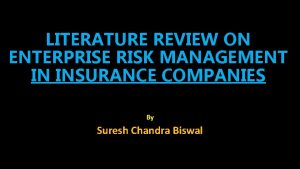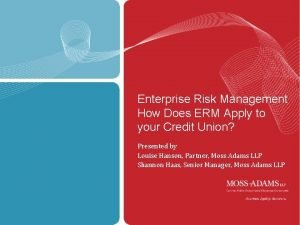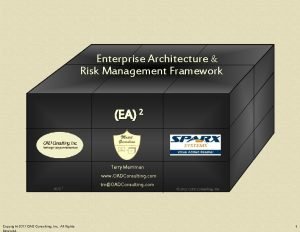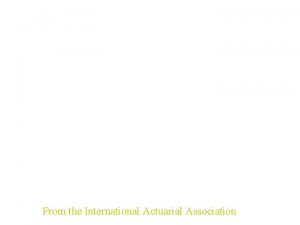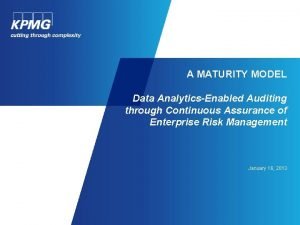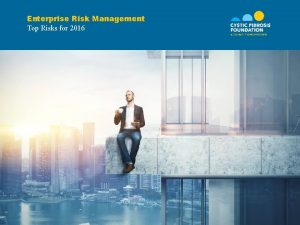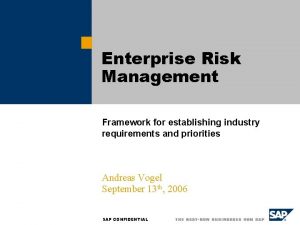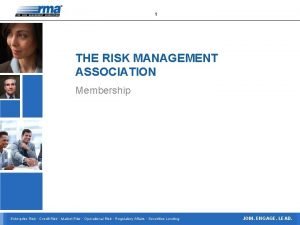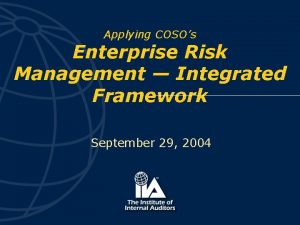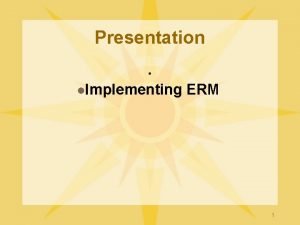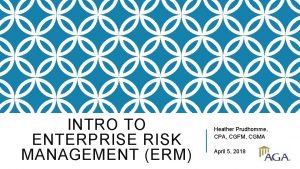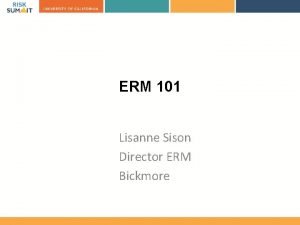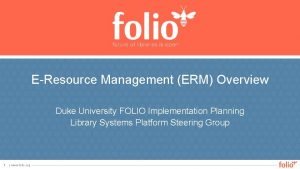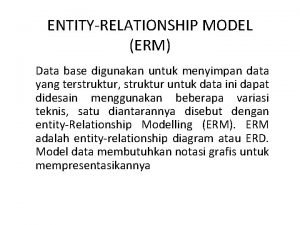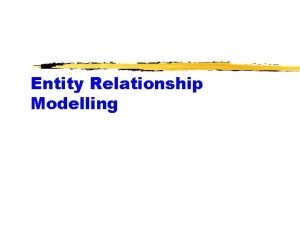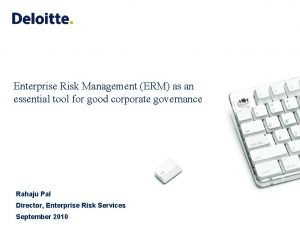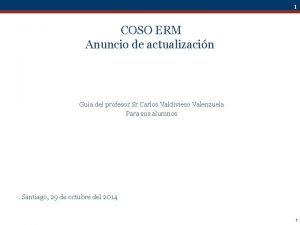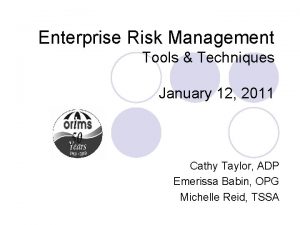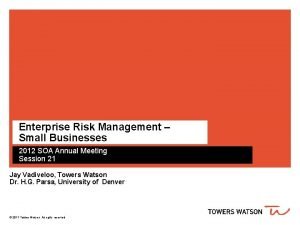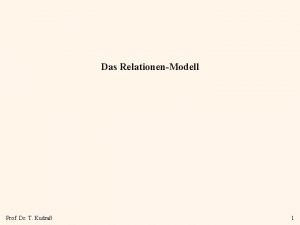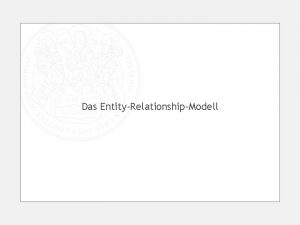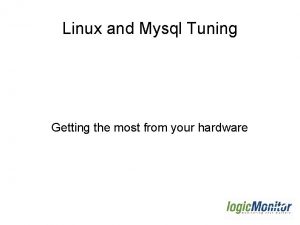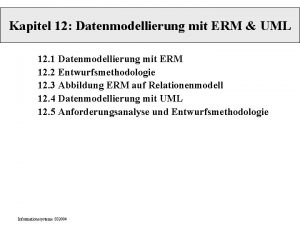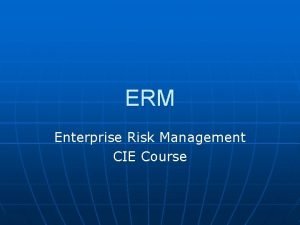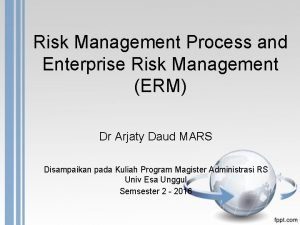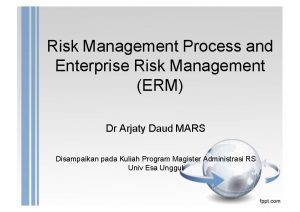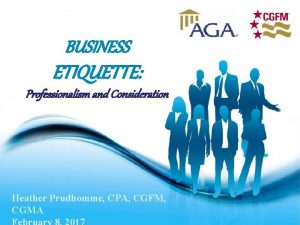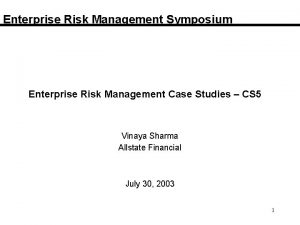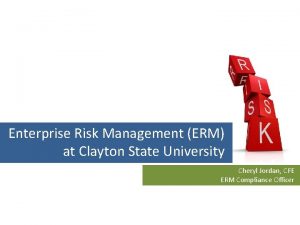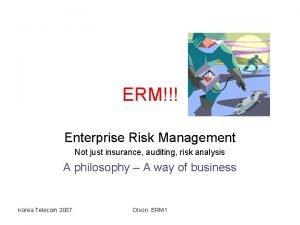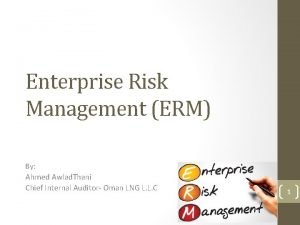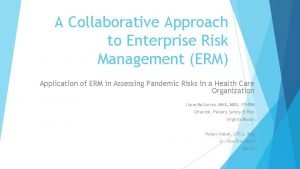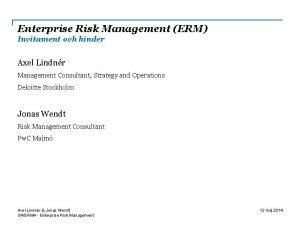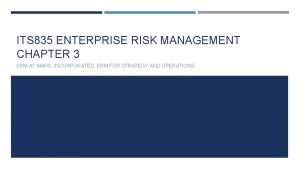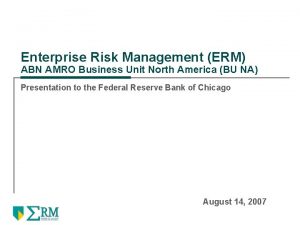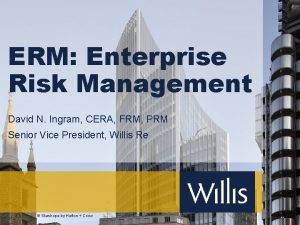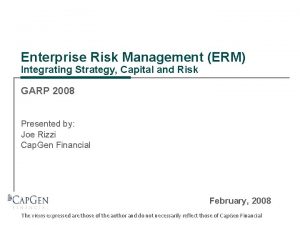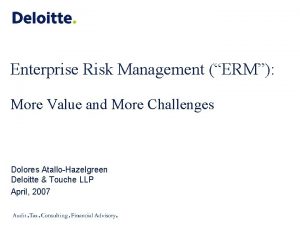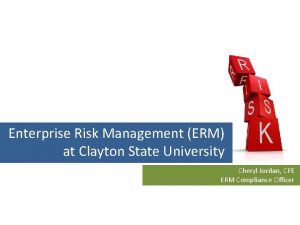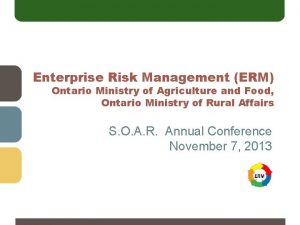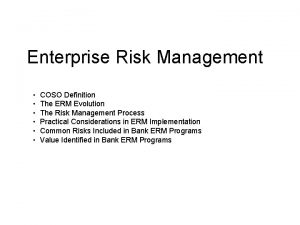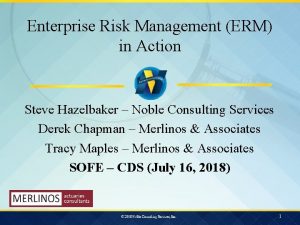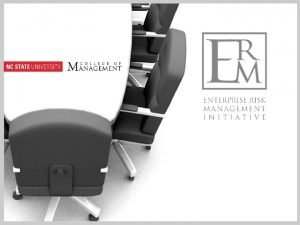INTRO TO ENTERPRISE RISK MANAGEMENT ERM Heather Prudhomme

































- Slides: 33

INTRO TO ENTERPRISE RISK MANAGEMENT (ERM) Heather Prudhomme, CPA, CGFM, CGMA April 5, 2018

AGENDA/TOPICS § What is Enterprise Risk Management? • Federal Applications § Principles § ERM Framework • Components of COSO Framework with Steps in OMB Circular A-123 § Roles and responsibilities within ERM § Developing the risk appetite and risk tolerance § Establishing a risk profile §Benefits § Pitfalls of implementation

WHAT IS IT? § The ERM Buzzword : § OMB A-123 Definition "ERM is an effective Agency-wide approach to addressing the full spectrum of the organization’s external and internal risks by understanding the combined impact of risks as an interrelated portfolio, rather than addressing risks only within silos. " §IIA Definition: “Enterprise risk management is a structured, consistent, and continuous process across the whole organization for identifying, assessing, deciding on responses to, and reporting on opportunities and threats that affect the achievement of its objectives. ”

What it IS NOT An ongoing, living capability and commitment to the evaluation of all risks, and their integration A one-time consideration A continuous way of thinking A documentation exercise A competitive advantage A compliance checklist A tool to enhance management decisionmaking, corporate governance, and accountability A departmental/silo function

HOW DOES IT APPLY TO STATE/LOCAL GOV? Ø Where the Feds go…… Ø State/Local entities are included in the concept of ‘Extended Enterprise’ Ø Grants, Fraud, Improper Payments, Disaster Relief Ø Maturing ERM models will need increasing information Ø A-123 Section “Managing Grant Risks in Federal Programs” (p. 47 -48)

APPROACHING RISK General Known Factors: § All organizations exist to achieve their objectives § Internal and external factors affect those objectives § Directly or indirectly, these factors cause uncertainly about achievement of objectives Overall effect of the uncertainty is “risk”

ERM VS. TRADITIONAL RISK MANAGEMENT (RM) §ERM takes an enterprise-wide approach § Considers potential impact of all types of risks on all processes, activities, stakeholders, products and services § RM risks are based on program or project executions – integration does not normally occur § Risk focus is more forward looking, but does not extend beyond program/project scope §ERM looks at both upside risk (opportunities) and downside risk (losses/damage) §ERM assesses risk and opportunity § Requires domain and technical expertise in specialized skillsets in the context of strategic objectives § Risk appetite and tolerance is not §ERM enhances existing strategic usually addressed planning and budgeting processes §ERM engages “risk owners” or subject matter experts to address and manage risks

CURRENT RISK ENVIRONMENT FACING FEDERAL GOVERNMENT • The Federal government is facing greater change than at any other point in time • Current budget realities mean government agencies compete for limited resources as never before • Budgets will go to those who best show value • There is greater scrutiny and expectations from internal and external stakeholders for agencies to respond to risk faster and more effectively • The continual focus of risk management on financial areas has limited the broader considerations of risk within organizations Major Management Challenges Could they have been avoided? Could the impact have been minimized and more manageable?

GOING FORWARD

REQUIRED BY A-123 FOR ERM IMPLEMENTATION

UPDATES – FIRST YEAR DOWN Rollout of requirements occurred in FY 17– what is happening now? • Still a key initiative of the current administration • Key focus for OMB - encouraging integration of ERM within strategic reviews and internal controls o These areas line up with two deliverables required by A-123 1) Integrate with Annual Strategic Reviews – Identification of key notations from risk profiles are made available for discussion with OMB as part of Agency Strategic Reviews o. Risk profiles required to be in place, but was non-deliverable to OMB in FY 17 2) Integrate with Evaluation of Internal Control – Agencies providing assurances about internal controls under FMFIA o In FY 17, OMB noted several agencies that reported on ERM in several locations o Going forward, further integration of areas is encouraged (Grants Management, Fraud Risk Management, Improper Payments, Data Integrity, etc. )

PRINCIPLES Underlying points for developing a risk culture § Governance Framework is Important § Managing Risk is Everyone’s Responsibility § Managers Own the Risk § Transparency Supports Informed Decision Making § Forums for Discussing Risk are Important § Risk Management Should Be Integrated into Key Agency Processes § Establishing a Risk Appetite is Key § Planning Fosters a Culture of Resilience § Diversity of People and Thought Aids Risk Management

RELATIONSHIPS

COMPONENTS OF ERM – COSO 2013 § Internal Environment § Objective Setting § Event Identification § Risk Assessment § Risk Response § Control Activities § Information and Communication § Monitoring

COSO ERM 2017 End Goal: Manage the Risks That Matter! NOT: Manage All the Risks that Exist *Represents a shift from process based risk assessment to strategy/objective linked risk assessment and management*


Enterprise Risk Management Model Overview: • 7 Cyclical Components • Establish the Context • Identify Risks • Analyze and Evaluate • Develop Alternatives • Respond to Risks • Monitor and Review • Continuous Risk Identification and Awareness • 3 Enterprise Components • Communicate and Learn • Extended Enterprise • Risk Environment/Context

INTERNAL ENVIRONMENT/ OBJECTIVE SETTING STEP 1: ESTABLISH CONTEXT § Determine the requirements and constraints that influence the decision making process § Evaluation of policy, mission needs, stakeholder interests/priorities, culture and acceptable risk levels § Consider how the existing control environment operates to ensure compliance with laws, regulations and policies

EVENT IDENTIFICATION STEP 2: IDENTIFY RISKS § Use a structured and systematic approach to recognize risks in meaningful categories § Address key risks significant to achievement of organizational objectives § In more formal process, having a risk register of all risks and their management is effective § Perform examination to determine highest risks for agency profile

RISK ASSESSMENT STEP 3: ANALYZE AND EVALUATE § Consider root causes, sources, and probabilities § Evaluate potential positive and negative outcomes § Perform prioritization of identified risks STEP 4: DEVELOP ALTERNATIVES § Identify and assess response options § Accept, transfer, share, avoid, or mitigate § Evaluate costs of addressing risks, and values of benefits § Consider control options that respond to risk

RISK RESPONSE STEP 5: RESPOND TO RISKS § Determine how to allocate resources to address § Document milestones for carrying out management process § Implement monitoring over the management process • Evaluate process for effectiveness and timeliness § Prepare and execute the selected response

CONTROL ACTIVITIES INFO & COMMUNICATION STEP 4: DEVELOP Processes in place should have ALTERNATIVES (con’t. ) § Consider control options that respond to risk § Controls are part of a full analysis of appropriate response to risks § Design for control options: preventative, corrective, directive or detective §OMB A-123 requires: § Management responsibility for the development and maintenance of effective internal controls § Management evaluation of internal control effectiveness provisions for alerting appropriate levels of management to: New or emerging risks Changes in identified risks Updates to risk environments or perceptions of threat/opportunity Responses to risks not in like with established risk appetite or tolerances

MONITORING STEP 6: MONITOR AND REVIEW § Evaluate performance of selected risk responses § Determine if selected option is achieving desired result § Develop continuous routine for ongoing assessment § Must be a constant process to watch for leading indicators of future risks, as well as changing risks in those already identified

RISK APPETITE & TOLERANCE Risk Appetite – Amount of risk that is willing to be accepted in pursuit of mission/vision Established at most senior levels of leadership Guidepost for setting strategy and selection of objectives Risk Tolerance – Acceptable level of variance in performance relative to the achievement of objectives Established at the program, objective, or component level Consideration given to relative importance of objectives Portfolio View – Having insight into ALL areas of organizational risk exposure

NOTE: A-123 recognizes the importance of the concepts of risk appetite and tolerance within an ERM framework, but does not actually require agencies to develop a risk appetite statement.

ROLES AND RESPONSIBILITIES WITHIN FRAMEWORK Board of Directors & CEO/Director - Charged with ultimate accountability for all risks. Practices must be discussed periodically and related policies must be reviewed and approved. Senior management - Should design, implement, and maintain effective framework. Develop policies and procedures, establish and monitor the risk appetite, and report regularly to the board of directors. Promote a risk-aware culture. Middle management and Business units - Must identify, assess, measure, monitor, control, and report risks to senior management. Manage relevant risks within the framework established and ensure compliance with policies and procedures. Support functions (i. e. Legal, HR, IT, etc) - Provide support to business units in developing and enforcing policies and procedures. Internal Audit & Compliance - Monitor and provide independent assurance of the effectiveness of the framework. Risk management - Coordinate the establishment of the framework and provide risk management expertise.

RISK PROFILING § Part of new OMB A-123 requirements is for agencies to maintain a risk profile § An effective profile provides an analysis of the risks that an organization faces toward achieving its strategic objectives, operations, reporting and compliance objectives § Identifies options for addressing risks arising from mission and missionsupport operations § Differs from a risk register in that it is a prioritized inventory of the most significant risks § MUST consider risks from the portfolio perspective AND be approved § MUST identify sources of uncertainly, and both positive opportunities and negative threats 1 st Milestone of ERM implementation: Risk Profiles due to OMB in June 2017

COMPONENTS OF A RISK PROFILE Agencies have discretion in terms of form and content, but should include the following components: 1. Identification of Objectives 2. Identification of Risk 3. Inherent Risk Assessment 4. Current risk response 5. Residual Risk Assessment 6. Proposed Risk Response 7. Proposed Action Category

BENEFITS OF ERM § Supports achievement of strategic objectives, operations, reporting and compliance objectives § Enhances institutional decision-making § Create a ‘risk-aware’ culture across the organization § Reduces operational surprises and losses § Prepares an organization to act on acceptable opportunities § Assures greater business continuity § Improves resource allocation by aligning risk and resources with strategic objects Links strategies and business through relationships in a continuous causal analysis

CRITICAL FACTORS FOR A MATURE FRAMEWORK Strategy: ERM is built into, and applied, across the organization Aligned with strategic objectives and risk appetite Engages employees at every level Environment: Culture supports success of framework Training and communication is provided to personnel and risk owners Roles and responsibilities are configured to promote efficient and effective risk-informed culture Assurance and communications are provided to management and the Board of Directors

CRITICAL FACTORS FOR A MATURE FRAMEWORK Process Execution: Ongoing ERM process has elements necessary to flow throughout organization Risk identification – risks that may impact strategy through integrated or cross-disciplined approach Risk Assessment – impact and prioritization of identified risks Risk Response – categories of avoidance or acceptance of risk and procedures for response Risk Control – adherence to procedures, policies and regulations Infrastructure: Systems, limits & methodologies provide a comprehensive view of risk Assists in identification of events that may affect the risk appetite Provides ongoing capability for analysis, monitoring and reporting

ERM PITFALLS – WHAT TO WATCH FOR § Design is not integrated § Focusing too much on Internal Controls § Narrow Focus on Financial View § Too Much, Too Quickly § Initiation of Overly Complicated Model § Absence of support from senior leaders § Lack of core team

QUESTIONS/FEEDBACK?
 Brigitte prudhomme
Brigitte prudhomme Brigitte prudhomme
Brigitte prudhomme Le cygne sully prudhomme
Le cygne sully prudhomme Market risk credit risk operational risk
Market risk credit risk operational risk Literature review on enterprise risk management
Literature review on enterprise risk management Enterprise risk management for credit unions
Enterprise risk management for credit unions Vertical slice architecture
Vertical slice architecture Enterprise risk management for financial institutions
Enterprise risk management for financial institutions Internal audit data analytics maturity model
Internal audit data analytics maturity model Omb a-123
Omb a-123 Enterprise risk management pharmaceutical industry
Enterprise risk management pharmaceutical industry Bindesh rach
Bindesh rach Enterprise risk management association
Enterprise risk management association Enterprise risk management integrated framework
Enterprise risk management integrated framework Fiduciary investment risk management association
Fiduciary investment risk management association Risk map
Risk map Putting the enterprise into the enterprise system
Putting the enterprise into the enterprise system Enterprise
Enterprise Ideally, an entity identifier is composed of
Ideally, an entity identifier is composed of Presentation l
Presentation l Erm benefits
Erm benefits Redrapme
Redrapme Folio erm
Folio erm Generalitation
Generalitation Entity relationship matrix
Entity relationship matrix Erm tool
Erm tool What is unary relationship in dbms
What is unary relationship in dbms Coso erm 2004
Coso erm 2004 Erm tools and techniques
Erm tools and techniques Soa erm
Soa erm 1 zu 1 beziehung relationenmodell
1 zu 1 beziehung relationenmodell Kardinalitäten chen notation
Kardinalitäten chen notation Mysql huge pages
Mysql huge pages Uml erm
Uml erm




